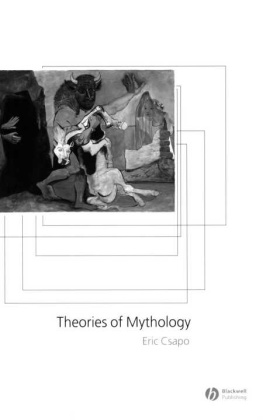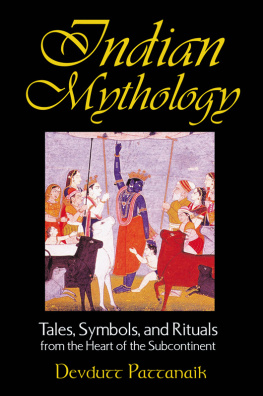These enjoyable, straightforward surveys of key themes in ancient culture are ideal for anyone new to the study of the ancient world. Each book reveals the excitement of discovering the diverse lifestyles, ideals, and beliefs of ancient peoples.
Markham J. Geller
Donald G. Kyle
Marilyn B. Skinner
John M. Wilkins and Shaun Hill





For my mother and father, Marg and Steven Csapo
Contents
1 1
Figures
Preface
This book presents the major schools of mythological interpretation: their theories, their methods, their insights, and their shortcomings. Each school of thought is represented by one or two key or founding figures. Their theories are explained, placed in their social and historical contexts, and then criticized. Their methods of analysis are described, exemplified, and problematized. This is an introduction: I require nothing of the reader but an inquiring mind. Sample analyses are all taken from Greek myth or stories which are likely to be familiar to most readers, but, where necessary, the myths are told with the analyses. The majority of the sample analyses come from the theorists themselves. But I have not hesitated to add several of my own, wherever I thought I could exemplify a method with greater simplicity or clarity, or wherever I had to deal with a theorist, such as Levi-Strauss, who worked mainly with obscure mythic material, or a theorist, such as Freud, who avoided extended analysis of myth altogether. The final chapter, for reasons which will be explained, deals not with a specific theorist, but with widespread contemporary theoretical trends. It exemplifies the method of ideological analysis which will already have an air of familiarity, having already been applied, broadly, in the criticism of the earlier theories of mythology themselves. The discovery of the shortcomings of this method I leave to the readers, the reviewers, and the future critical discourse on myth.
In pursuing so ambitious a project, I have necessarily been selective. The list of theorists who do not appear in this book is very long. Famous and important names, like Jung, receive only passing mention, and others, like Dumezil or Girard, none at all. Although this book is, I believe, in its way, the most comprehensive general introduction to theories of myth, it is far from complete. This is partly due to reasons of practicality and cost, but has also much to do with design. I have used important figures largely to exemplify the orientation and tendencies of a whole school of thought at a given point in time. The detailed enumeration of variant opinions within a school seemed to me more likely to obscure the exposition of the general trends and to seem to most nonprofessionals as dull name-dropping. There are names and variants enough in the pages of this book, but they are mentioned mainly for the sake of illustrating a general principle. The professional reader will find much that could have been stated with more reservation, qualification, and a host of quasi-exceptions. I leave no footnotes and no regrets. The devil is too often lost in the detail. This is a book about large contours.
The most conspicuous difficulty with the selections I have made, particularly the focus on key and founding figures, is the impression it may leave that many of these approaches died when their shortcomings were discovered, or at least failed to evolve beyond them. This is true in the case of solar mythology, much less true in the case of psychoanalysis and structuralism, and certainly not true in the case of comparatism or ritualism. In most cases these schools evolved, when they did evolve, by absorbing and taking into account the criticism of the schools that followed them. Not everyone who practices the comparative method thinks like James Frazer, but comparatism is still a useful method insofar as it takes account of the criticisms that are and were leveled against him. The order of exposition, the links between the criticism of one theory and the presentation of the next, are designed to suggest a dialogue, or rather a dialectic process. Some familiarity with all of these theories is required in order to have a real understanding of any of them. Some appreciation of the relations between theories is necessary for any who will grasp the progress, if there has been any, in our understanding of myth.
Why study dead theories at all? With the exception of solar mythology there are no dead theories in this book, though there are a fair number of dead theorists. The history of the science of mythology (if we can call it that, and I will) does not resemble a revolving door. The theories we have examined were not simply canceled and replaced when their faults came to light. Most of the theories studied in this book live on in their own right. Moreover, they live on in one another. Each new theory reacted to and corrected the faults of the earlier theory. But it also incorporated a great deal of what it did not reject. By the same token, the adherents of earlier theories have reacted to and incorporated the insights and criticisms of later theories. It is partly this dialogue that has made possible the current fashion for theoretical eclecticism. Different approaches are better for producing different results, while the more fundamental incompatibilities have often been expunged.
Throughout the book I have emphasized the importance of the theorists' social and theoretical contexts. It will soon become obvious that I believe that there has been progress in the science of mythology, but that this progress has been stunted by the limited perspective and false accents created by the social ideologies of its practitioners, and also stimulated by the rational criticism of those who reacted to and exposed the limits and errors of their predecessors. The social background to theorists and theories is not just presented for the sake of human interest and local color: it is vitally important for understanding just why and how a theorist should take the peculiar and sometimes otherwise unintelligible perspectives that he does. Social background does not serve only as a negative factor in this history. Different backgrounds, different times, and different perspectives also enable other theorists to detect and demystify the mythopoeic activity of ideology, even if the rational criticism is only enabled by a different ideological perspective. I do not share the resignation of those who see nothing but one ideology replaced by another equally deleterious ideology. It is true that ideology is likely always to be present in any science, but so is rational discourse, and not in equal measure, but in inverse proportions to one another.












